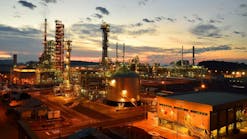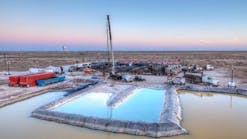Stephen BlashkaAn improved technique for ex situ catalyst presulfurizing has been successfully applied in several hydrocracker start-ups, including one at Citgo Petroleum Corp.'s refinery in Lake Charles, La.
CRI International Inc.
HoustonGeoffrey Bond
Citgo Petroleum Corp.
Lake Charles, La.David Ward
Shell Chemical Co.
Houston
Because hydrocrackers are critical process units, refiners have a strong incentive for minimizing the units' downtimes. Catalyst that is ex situ presulfurized using CRI International Inc.'s actiCAT process offers the potential for significant time savings over conventional in situ sulfiding without the temperature spikes associated with earlier-generation presulfurized products.
In situ sulfiding chemistry
Metal oxides must be converted to metal sulfides-the active/stable form of the catalyst-prior to use. Typically, NiMo and NiW catalysts used in hydrocracking are supplied with the active metals in an unstable oxide form (e.g., MoO3, NiO, WO3). If the catalyst operates in this form, it would deactivate to end-of-run condition in a few weeks.Fig. 1a [68,745 bytes] shows the chemical reactions involved in sulfiding. In sulfiding reactions, metal oxides react with hydrogen and H2S to form metal sulfides in the temperature range of 400-650° F. The reactions are exothermic and generate water. As long as H2S is present, the sulfiding reactions are chemically favored over the reduction reactions.
If the catalyst is heated above 450° F. without H2S present, the metal oxides can be reduced to a base metal. The base metal would then agglomerate, resulting in permanent activity loss.
Catalyst can be sulfided in situ with a sulfur-containing spiking agent, sour gas, or feedstock.
In general, liquid-phase sulfidings (oil and hydrogen flow) are preferred because the oil acts as a heat sink for the sulfiding exotherm and helps distribute the sulfur evenly across the catalyst bed.
However, hydro crackers with zeolite-containing cracking catalyst are usually gas-phase sulfided (hydrogen flow only) because of the potential for runaway hydro cracking. These high-activity zeolitic catalysts start cracking the start-up oil before the catalyst can reach a temperature high enough to complete the sulfiding.
In situ sulfiding process
Gas-phase sulfiding of hydrocracking catalyst is a slow, tedious process. Fig. 2 [33,329 bytes] shows a timeline for an in situ sulfiding with a spiking agent. First, the reactor is heated to 300° F. and held for several hours to dry out the catalyst. Then, the reactor temperature is increased to 400-450° F. and held there to heat up the reactor walls.Because of brittle fracture concerns, unit pressure is typically limited to about 25% of design until the reactor walls are heated above the minimum pressuring temperature (MPT), which is typically in the range of 200-300° F.
Depending on the size and the age of the reactor, it can take more than 24 hr to heat up the reactor walls. Once the walls are above the MPT, the unit is pressured up to full operating pressure.
Having the unit at full pressure before starting the sulfiding chemical injection is usually preferable because it provides a better heat sink for the sulfiding exotherm. Also, the higher mass flux at high pressure may help distribute the sulfiding chemical more evenly across the catalyst bed.
After the unit is pressured up, sulfiding chemical is injected at a reactor temperature of 400-450° F. until H2S is detected in the reactor effluent. The rate of chemical injection during the initial sulfiding must be limited to avoid an excessive temperature rise across the reactor. If the catalyst in the bottom of the reactor is heated above 450° F. before H2S breakthrough is achieved, the catalytic metals may be reduced.
Once H2S breakthrough is achieved, the catalyst is heated to 700° F. to complete the sulfiding. The reactor temperature must be increased slowly to maintain H2S breakthrough and to avoid an excessive temperature rise in the reactor.
In the example shown in Fig. 2, injection of the required amount of sulfiding chemical took 44 hr. This example is a commercial gas-phase sulfiding of a hydro cracker that is similar to Citgo's unit at Lake Charles. The hydrocracker in the example is a series flow unit with 700,000 lb of pretreat and cracking catalyst.
Ex situ presulfurizing
By comparison, the activation of actiCAT presulfurized catalyst is fast and easy. The catalyst is simply heated in the presence of hydrogen. As the presulfurized catalyst is heated above 300° F., it starts to activate, converting the metal oxysulfides to metal sulfides while generating H 2S, water, and heat. Fig. 1b shows a diagram of the activation of presulfurized catalyst.There is no need for a dry-out step because the presulfurized catalyst is dried prior to processing. Furthermore, because the catalyst pores are filled with sulfiding chemicals, it has much less affinity for water.
Also, there is no hold at 400-450° F. to heat up the reactor walls because the activation typically takes place at low pressure. The presulfurized catalyst starts activating before the reactor walls can reach the minimum pressuring temperature.
Because of the lower heat sink at low pressure, exotherms are a concern (see next section). Also, although the flow distribution may be less uniform at low pressure, this is not a problem because each pellet of the presulfurized catalyst already contains sulfur.
In the example in Fig. 2, actiCAT presulfurized catalyst saves 40 hr compared with in situ sulfiding. For turnarounds where the hydrocracker is critical path, this saved time has tremendous value to the refiner. For example, the time savings for a 38,000 b/d hydrocracker with a typical upgrading value of $5/bbl is worth $315,000.
In addition to time savings, there are many other factors to consider when deciding between presulfurized catalyst and in situ sulfiding. These include safety and environmental issues, ability to provide high catalyst activity, reliability of the sulfiding chemical injection pump, the configuration and operating constraints of the unit, and the relative costs of each method.
Exotherms
Although using presulfurized catalyst in hydrocrackers offers significant time savings, there are technical concerns about the potential for a large temperature rise, commonly know as an "exotherm," during catalyst activation.As mentioned earlier, presulfurized hydrocracking catalyst is typically activated by hydrogen flow at low pressure so there is a much smaller heat sink to remove the heat that is generated. Also, hydrocrackers generally contain large volumes of catalyst-in the range of 400,000 lb to 1 million lb-so a large amount of heat must be removed during activation.
To address these concerns CRI specifically developed its actiCAT presulfurizing process to minimize exotherms during start-up (OGJ, Oct. 10, 1994, p. 56). The process binds sulfur to the catalyst in an organic matrix.
This process generates a range of metal oxysulfides that are converted to metal sulfides over a wide temperature range. This results in a gradual activation with minimal exotherms.
Fig. 3 [34,790 bytes] compares the rate of heat release during the activation of actiCAT catalyst vs. catalyst that was presulfurized by a competitor's process that uses organic polysulfide (OGJ, Feb. 24, 1992, p. 49). These data were generated by a differential scanning calorimeter (DSC), which measures the rate of heat release (i.e., temperature rise) as the presulfurized catalyst samples are heated in a hydrogen atmosphere. The DSC simulates the actual conditions inside the reactor during the catalyst activation.
The DSC trace for the actiCAT catalyst shows a small amount of activation around 300° F., with the bulk of activation occurring between 400° F. and 600° F. This trace illustrates the slow rate of activation over a wide temperature range. In contrast, the catalyst that was presulfurized with organic polysulfide reacts very quickly over a narrow 50° F. temperature range.
Commercial presulfurizing examples
The reduced exotherms predicted by the DSC were observed commercially during several hydrocracker start-ups. In early 1994, Citgo, in Lake Charles, used catalyst that was presulfurized with organic polysulfide in its hydrocracker. The pretreat reactor (D-1) was loaded with Criterion DN-120, a high-activity NiMo catalyst for nitrogen removal.Fig. 4 [34,640 bytes] shows the temperatures in the bottom bed of the pretreat reactor during the catalyst activation. The catalyst started reacting rapidly at a bed inlet temperature of about 350° F. Over the next 10 min, the bed outlet temperature increased by 350° F., peaking at 700° F. It is likely that this rapid temperature rise reduced some of the metals on the catalyst, resulting in lower start-of-run activity.
A short time after the Citgo start-up, CRI commercialized its actiCAT-HC process for presulfurizing hydrocracking catalyst. In the spring of 1996, the first start-up using the presulfurized Criterion/Zeolyst catalyst took place in a European hydrocracker.
Fig. 5 [107,465 bytes] shows the temperatures in the pretreat reactor during the activation of the presulfurized Criterion 411 catalyst. The activation was gradual and controlled with a maximum temperature difference of only 40° F. across the bottom catalyst bed.
The activation of Zeolyst 713 catalyst in the cracking reactor was even more controlled-with temperature differences of less than 20° F. Typically, the largest exotherms are observed in the pretreat reactor because the pretreat catalyst has a higher stoichiometric sulfur requirement than the cracking catalyst, and NiMo catalyst sulfides more rapidly than NiW catalyst.
Citgo hydrocracker start-up
The hydrocracker at Citgo's refinery in Lake Charles is a series flow unit with oil recycle. Fig. 6 [59,529 bytes] shows a schematic of the unit. The unit has one pretreat reactor and two cracking reactors, which hold more than 800,000 lb of catalyst. The hydrocracker processes 38,000 b/d of gas oil and cycle oil feeds and upgrades them to naphtha and jet fuel.In early 1997, Citgo performed a turnaround on the unit. The refinery once again selected Criterion DN-120 for the pretreat reactor and Zeolyst Z-753 and Z-763 for the cracking reactors.
Citgo was interested in using presulfurized catalyst but was concerned because of its previous problems with exotherms. Because the refinery had used actiCAT presulfurized catalyst in other process units, it had seen first-hand the reduced start-up exotherm.
By this time, several changes of actiCAT catalyst had been successfully started up in hydrocrackers. Except for one bottom layer of catalyst in the pretreat reactor, Citgo decided to use actiCAT presulfurized catalyst in its hydrocracker.
In the bottom of the pretreat reactor, Citgo decided to use 40,000 lb of DN-120 left over from 1994. This material had been presulfurized with organic polysulfide and had generated large exotherms in 1994 (Fig. 4 [34,640 bytes]). On top of this catalyst, Citgo placed the actiCAT presulfurized catalyst.
Figs. 7a and 7b [178,457 bytes] contrast the temperature profile of the organic-polysulfide presulfurized catalyst and the actiCAT presulfurized catalyst in the pretreat reactor during start-up.
Shortly after hydrogen was introduced to the unit, the actiCAT catalyst started to activate, causing a temperature wave to pass through the reactor. The actiCAT activation was gradual with the bottom of the actiCAT catalyst reaching peak temperatures of only 370° F. Fig. 7c [178,457 bytes] shows the temperatures of the actiCAT presulfurized DN-120 in the pretreat reactor during start-up.
When the heat reached the bottom of the reactor, the organic-polysulfide presulfurized catalyst reacted rapidly. The temperature increased from 330° F. to 520° F. in less than 10 min. Although maximum quench was added above the catalyst bed, the temperature of one of three thermocouples continued to increase. Over the next 4 min, the temperature increased more than 200° F., peaking at 745° F. Because the large exotherm was limited to only one of thirty thermocouples, its effect on catalyst activity was minimal.
Fig. 8 [184,402 bytes] shows the temperatures in the first cracking reactor (D-2) during activation. As the cracking catalyst was heated above 475° F., it began to activate. Small temperature differences of less than 40° F. were seen across the cracking catalyst beds, and water was detected in the high-pressure separator.
Although the heat from the pretreat reactor carried through to the cracking reactors, it did not initiate any significant exotherms in those reactors. After the temperature wave passed through the reactors, the catalyst heated up to 650-700° F. to complete the activation.
Almost 800,000 lb of actiCAT presulfurized catalyst was successfully activated in Citgo's hydrocracker. The activation only took 24 hr to complete and probably could have been done faster if operating problems on the unit had not caused delays. The performances to date of both pretreat and cracking catalyst have been excellent.
After the initial break-in period, the pretreat reactor has stabilized at a weighted average bed temperature (WABT) that is in-line with that predicted by Criterion/Zeolyst.
Presulfided vs. Presulfurized
Although catalysts are often described as being ex situ "presulfided," the ex situ processes described in this article do not completely convert the catalytic metal oxides to metal sulfides. Rather, these processes convert metal oxides to complex metal oxysulfides.The technically correct term for the ex situ catalyst process is "presulfurized" rather than "presulfided." When heated with hydrogen during the activation, the oxysulfides break down to form metal sulfides directly or to form H2S, which converts the metal oxides to metal sulfides.
Stephen Blashka is the technical services manager for CRI International Inc.'s presulfurizing, regeneration, and density grading services in Houston. Before joining CRI in 1994, he worked for Amoco Oil Co. He holds a BS in chemical engineering from Northwestern University, Evanston, Ill.
Geoffrey Bond is a process engineer with Citgo Petroleum Corp. Since joining Citgo in 1991, Bond has worked with hydrocracking, reforming, aromatics extraction, hydrotreating, fluid catalytic cracking, and delayed coking processes. He holds a BS in chemical engineering from the University of Texas at Austin.
David Ward is a research engineer with Shell Chemical Co. He also provides technical support for Zeolyst International by providing direct support to users of Zeolyst hydrocracking catalysts as well as to Zeolyst's research and development program for new catalysts and process modeling. Ward holds an ScB in engineering from Brown University, Providence, R.I., and a PhD in chemical engineering from Carnegie Mellon University, Pittsburgh.
Copyright 1997 Oil & Gas Journal. All Rights Reserved.




